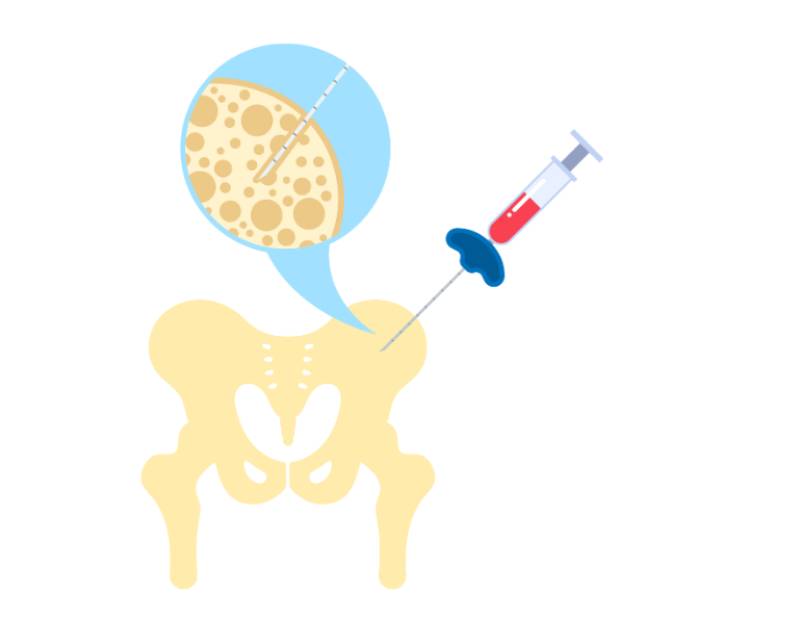
30 Jun, 2025

30 Jun, 2025

This article is medically reviewed by Dr. Aditi Kaskar, Consultant – Hemato Oncology & BMT Physician, HCG Cancer Centre, Borivali
Hematopoietic stem cells refer to those cells that are found in bone marrow, and they can develop into various types of blood cells.
The bone marrow is located in the central space of long bones, and different types of blood cells, like red blood cells, white blood cells, platelets, etc., are formed here.
In some blood disorders, like acute leukemia, aplastic anemia, thalassemia, etc., the bone marrow is not able to produce normal blood cells.
A bone marrow or hematopoietic stem cell transplant is a procedure that involves transplanting healthy stem cells into the patient's blood, which then go into the patient’s bone marrow and form normal blood cells.
The effectiveness of BMT depends on the type of cancer or condition treated, its stage, the entire treatment plan, and the overall health condition of the patient.
When a patient has a certain blood-related illness, like aplastic anemia, leukemia, etc., the existing blood cells are harmed, killed, or are not functioning properly.
To destroy the diseased bone marrow cells (cancer cells and healthy cells), high-dose chemotherapy is given to the patient. This chemotherapy will cause patients’ blood counts to drop.
The stem cells are collected from the donor via a peripheral intravenous catheter (similar to a blood donation).
The stem cells are infused into the patient via an IV, similar to a blood transfusion. These stem cells will then develop into normal blood cells inside the patient’s body and carry out designated functions.
Bone marrow transplant, or haematopoietic stem cell transplant, is a treatment approach with a curative potential in certain blood disorders. We, at HCG, recommend different types of BMT for various types of cancerous and non-cancerous blood diseases. Along with personalizing BMT care, we also look at adopting latest approaches that make this treatment more effective, safe, and comfortable for our patients. - Dr. Aditi Kaskar
The stem cells are infused into the patient via an IV, similar to a blood transfusion. These stem cells will then develop into normal blood cells inside the patient’s body and carry out designated functions.
During this process, the patient is kept in a special isolation ward called the BMT unit until their complete recovery, and this may take 2-4 weeks depending on the type of transplant.
It is important to note that bone marrow transplantation is not a surgical procedure.
Allogeneic stem cell transplant is the only curative treatment for certain cancerous and non-cancerous disorders like acute myeloid leukemia, acute lymphoblastic leukemia, chronic myeloid leukemia, myelodysplastic syndrome, multiple myeloma, lymphoma, aplastic anemia, thalassemia, immunodeficiency disorders, bone marrow failure syndromes, etc.
There are two main types of bone marrow transplants, depending on the donor used.
In this type of bone marrow transplant, the patients themselves are the donors.
Autologous stem cell transplants are recommended for blood cancers like multiple myeloma, Hodgkin’s lymphoma, and non-Hodgkin’s lymphoma. It increases the duration of remission in cancer.
During this procedure, healthy stem cells are collected from the patient’s body, following which high-dose chemotherapy is given, and then the stem cells are infused back into the patient.
The patients may expect the administration of growth factor injections to promote the release of stem cells from the bone marrow.
Recovery from this procedure may take 2-4 weeks.
An allogeneic stem cell transplant is a type of bone marrow transplant that involves transplanting the stem cells of another person into the patient. The stem cell donor may or may not be related to the patient.
Depending on the type of donor, allogeneic stem cell transplants are further classified into 4 subtypes:
1. Fully-matched related donor
2. Half-matched related donor
3. Fully-matched, unrelated donor
4. Unrelated cord blood donor
This procedure is done in cases of aggressive blood cancers like acute myeloid leukemia and acute lymphoblastic leukemia disorders where normal blood cell production is severely hampered, like aplastic anemia, myelodysplastic syndrome, primary myelofibrosis, thalassemia major, etc.
Allogeneic stem cell transplantation is the only curative treatment available for these disorders.
The patient receives high-dose chemotherapy with or without radiation therapy to destroy diseased bone marrow cells.
At the same time, the donor receives an injection to increase the stem cell count in the blood for 4 days, and stem cell collection is done via peripheral venous access by a process called apheresis. There is no immediate or long-term harm to the donor.
These stem cells are then infused into the patient.
Recovery from this procedure may take 3–6 weeks, depending on the type.
First and foremost, the overall outcome depends on the type of disease and the overall fitness status of the patient.
The outcome varies depending on the type of transplant.
An explicit treatment plan by the BMT specialist and good supportive care provided by a multidisciplinary approach are also key factors in improving patient outcomes.
A bone marrow transplant is a complex and time-consuming process. It involves several advanced technologies, such as stem cell apheresis, cryopreservation, conditioning chemotherapy, radiation therapy, and a multidisciplinary approach. It required a special BMT ward to provide isolation and prevention from infection.
Further, only experienced stem cell transplant specialists can effectively perform the procedure. At HCG Cancer Centre, we believe in bringing the best in cancer care to our patients. As a leading cancer hospital in Mumbai, we have advanced facilities for stem transplant procedures.
The center has state-of-the-art machines for obtaining and storing stem cells. A team of experienced stem cell transplant specialists performs the procedure.
A bone marrow transplant is the procedure in which the stem cells from the donor are transplanted into the patient. The procedure treats various types of cancerous and non-cancerous blood disorders. There are two main types of transplants: autologous and allogeneic. Clinicians consider several factors when choosing the most suitable type of transplant for a particular patient.
No, BMT is not a surgical procedure. It is a treatment that involves chemotherapy, stem cell infusion, and recovery. The entire process can take up to 3–6 weeks, depending on the type of transplant.
Bone marrow transfusion is the only curative treatment option for certain cancerous and non-cancerous blood disorders; there is no other alternative to this.
The life expectancy after BMT can vary from one case to another and is mainly dependent on the type of blood disorder, type of transplant, and overall condition of the patient.
Yes, after a bone marrow transplant, patients can recover and lead a normal life.
Hematopoietic Stem Cell Transplants: Principles and Indications
Indications for Haematopoietic Stem Cell Transplantation for Haematological Diseases, Solid
Tumours and Immune Disorders: Current Practice in Europe, 2019
A General Practitioner’s Guide to Hematopoietic Stem-Cell Transplantation

Dr. Aditi Kaskar
MBBS, DNB (Internal Medicine),
DrNB (Clinical Hematology)
Consultant – Hemato Oncology & BMT Physician
Dr. Aditi Shah Kaskar is an adept hemato oncologist and BMT physician practicing at HCG Cancer Centre, Mumbai. Her expertise lies in the treatment and management of malignant and non-malignant blood disorders among adult and pediatric patients. She is extensively trained in the administration of both autologous and allogeneic bone marrow transplantation programs. Dr. Aditi is known for her compassionate approach to patient care, prioritizing the comfort and well-being of her patients.
To book an appointment with Dr. Aditi Kaskar, please click here.